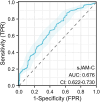sJAM-C as a Potential Biomarker for Coronary Artery Stenosis: Insights from a Clinical Study in Coronary Heart Disease Patients
- PMID: 39726644
- PMCID: PMC11669540
- DOI: 10.2147/DMSO.S478526
sJAM-C as a Potential Biomarker for Coronary Artery Stenosis: Insights from a Clinical Study in Coronary Heart Disease Patients
Abstract
Purpose: Coronary artery stenosis caused by atherogenesis is a major pathological link in coronary heart disease (CHD), which is a leading cause of global morbidity and mortality. Junctional adhesion molecule C (JAM-C) presents more and more association with atherosclerosis. However, no studies have shown the relationship between soluble JAM-C (sJAM-C) and the degree of coronary artery stenosis. This study aimed to analyze the effect of sJAM-C on coronary artery stenosis and to verify whether sJAM-C could be a biomarker for coronary artery stenosis.
Patients and methods: The participants registered at the Beijing Luhe Hospital, Capital Medical University in the cross-sectional study. A total of 121 patients without coronary stenosis and 408 patients with coronary artery stenosis were enrolled after matching age and sex. Demographic information, medication history, and laboratory data were collected. The level of serum sJAM-C was detected by enzyme-linked immunosorbent assay (ELISA) kits. We used the logistic regression model to evaluate the association between sJAM-C and coronary artery stenosis. Furthermore, the receiver operating characteristic (ROC) curve and area under curve (AUC) were used to evaluate the diagnostic value of sJAM-C on coronary artery stenosis.
Results: The serum level of sJAM-C was remarkably higher in patients with coronary artery stenosis than those without stenosis (p < 0.0001). Logistic regression models showed that there were positive association between serum sJAM-C level and coronary artery stenosis after adjustment, with corresponding ORs were 3.088 (95% CI 1.922-4.960, p < 0.0001). And the ROC curve revealed a sensitivity of 65.7% and specificity of 60.3% with AUC of 0.676 (95% CI 0.622-0.730) for the diagnosis of coronary artery stenosis with serum sJAM-C at a cut-off value of 18.1 pg/mL, indicating a certain diagnostic value.
Conclusion: In summary, higher serum sJAM-C level was possibly associated with the more severe coronary artery stenosis. Additionally, sJAM-C demonstrates a certain diagnostic value of coronary artery stenosis. These findings suggest sJAM-C may be a biomarker for coronary artery stenosis.
Keywords: atherosclerosis; coronary artery stenosis; coronary heart disease; soluble JAM-C.
© 2024 Wang et al.
Conflict of interest statement
The authors report no conflicts of interest in this work.
Figures



Similar articles
-
Homophilic Interaction Between Transmembrane-JAM-A and Soluble JAM-A Regulates Thrombo-Inflammation: Implications for Coronary Artery Disease.JACC Basic Transl Sci. 2022 May 23;7(5):445-461. doi: 10.1016/j.jacbts.2022.03.003. eCollection 2022 May. JACC Basic Transl Sci. 2022. PMID: 35663628 Free PMC article.
-
Serum soluble TREM2 is an independent biomarker associated with coronary heart disease.Clin Chim Acta. 2023 Aug 1;548:117499. doi: 10.1016/j.cca.2023.117499. Epub 2023 Aug 1. Clin Chim Acta. 2023. PMID: 37536519
-
Increased Circulating Soluble Junctional Adhesion Molecules in Systemic Sclerosis: Association with Peripheral Microvascular Impairment.Life (Basel). 2022 Nov 4;12(11):1790. doi: 10.3390/life12111790. Life (Basel). 2022. PMID: 36362943 Free PMC article.
-
[Relationship between serum levels of osteoproteins, inflammatory cytokines and coronary heart disease and disease severity].Zhonghua Wei Zhong Bing Ji Jiu Yi Xue. 2019 May;31(5):588-593. doi: 10.3760/cma.j.issn.2095-4352.2019.05.013. Zhonghua Wei Zhong Bing Ji Jiu Yi Xue. 2019. PMID: 31198145 Chinese.
-
Diagnostic accuracy of coronary angiography using 64-slice computed tomography in coronary artery disease.Saudi Med J. 2015 Oct;36(10):1156-62. doi: 10.15537/smj.2015.10.12415. Saudi Med J. 2015. PMID: 26446324 Free PMC article. Review.
Cited by
-
Junctional adhesion molecule-C: A multifunctional mediator of cell adhesion.Cell Mol Life Sci. 2025 Aug 13;82(1):312. doi: 10.1007/s00018-025-05829-z. Cell Mol Life Sci. 2025. PMID: 40801950 Free PMC article. Review.
References
-
- Ference BA, Ginsberg HN, Graham I, et al. Low-density lipoproteins cause atherosclerotic cardiovascular disease. 1. evidence from genetic, epidemiologic, and clinical studies. A consensus statement from the European atherosclerosis society consensus panel. Eur Heart J. 2017;38(32):2459–2472. doi:10.1093/eurheartj/ehx144 - DOI - PMC - PubMed
LinkOut - more resources
Full Text Sources

